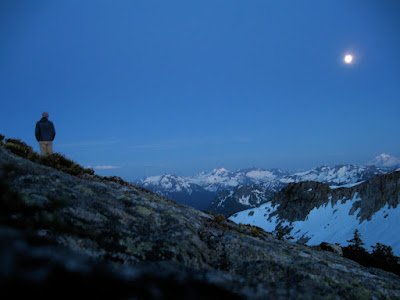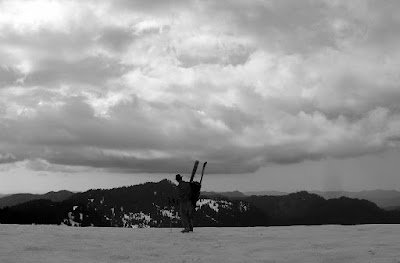After most backpacking trips Andrew and I have taken, I hear these words: "It was good, but not as good as the Sierra. You should go hike in the high Sierra, the best mountains in the world." I understand having favorite mountains, but by now the mountains of northern California have been built up so high that I fear grand-scale disappointment when I take my first trip. Here in Washington, we finally on a trip that rivaled the Sierras enough to stop these declarations. Of course the "I want to ski this" comments abounded, but the "You should go to California" comments were shushed.
We headed out for a long weekend to do some hiking in the Glacier Peak Wilderness area. Lyman Lakes loop was our destination. Most of the first day was spent in a slow, steady ascent in the trees. Although this was not delivering on the views, we did come across something that peaked our interest: pack goats.
I was sitting with our gear, waiting for Andrew to drop off the car at our endpoint and hitch a ride back to the trail head when I saw them first. A friendly guy out for a backpacking trip with his gear-laden group of goats. Ben, a white and black goat with a sweet-ass beard and loud bell, came over and sniffed me for awhile, licked my forehead, blew goat snot in my face, then attempted to eat my map. The owner apologized and tried to round up the other three goats to hit the trail. The rounding up part did not look like fun, as the goats were totally content destroying every huckleberry bush in sight. I can't blame them, huckleberries are delicious.
A wild pack of family goats
I excitedly told Andrew about the goats when he returned, and we took off on the trail, hoping to catch up with them. It ended up that we played leap-frog with the goat pack several times that day (maybe it was intentional), and every time we had a battery of questions for the guy: "How many pounds can they carry?", "How do you train them", "What do they eat on the trail, do you have to bring extra food?", "Can they go over glaciers?", "Can they carry skis?". We sadly said goodbye as the heartwarming group set up camp before the climb to Buck Creek Pass. Andrew was quiet for awhile, then says "I think it could be done, really". And by "it" I knew he meant finding a baby mountain goat, bottle feeding it, training it to carry gear, and using it to carry skis to the top of mountains. The trouble is having the heart to steal a baby mountain goat from its mother...
We continued on in the trees. Dusk was threatening when we emerged above tree line into views of jagged, crowding peaks with meadows of dying bear grass backlit by the setting sun. As we hit Buck Creek Pass, Glacier Peak in all of its splendor, popped out from hiding.
View back over Buck Creek Valley Dying bear grass
Dying bear grass
We climbed to the top of Flower Dome where we had great views in every direction for about 10 minutes. Suddenly, and I mean suddenly (less than 4 minutes), the clouds moved in. One moment, a clear beautiful night with peaks as far as you could see, and the next minute fog so thick you couldn't make out the moon.
From our campsite as the fog rolls in In the fog
In the fog
We set up camp on a people-free yet foggy summit, and cooked dinner. Lately we have been stepping it up a notch in the back-country cooking department. Instant mashed potatoes can shockingly get old. One of our backpacking partners last week brought a delicious pork vindaloo for dinner the first night, which I tried to recreate on this trip. The gourmet dish was mighty flavorful, but I didn't grind the spices sufficiently. We kept biting into whole sticks of cinnamon or cardamom seeds that made our mouths go numb. Nonetheless, it was delicious, and my pack was much lighter sans Indian food the next day. Full and warm, we fell to sleep in the fog, with the sounds of marmots whistling.
Glacier from the top of Flower Dome
The next morning rang clear, and views of Glacier were f-a-b-u-l-o-u-s. We hit the trail doing the down-up dance over three passes: Middle Ridge, Suiattle Pass, and Cloudy Pass. Cloudy Pass ended up not being cloudy at all, and we found a perfect bivy spot for the night on a ledge overlooking Lyman Lakes. It was early in the afternoon, but we opted to make our hike out a little longer the next day and camp on higher ground in desolation, rather than descend to the lakes into crowds and fewer views. Hitting camp early made for a relaxing afternoon: exploring the surrounding knobs, meadows, and streams, making popcorn, and napping in the afternoon sun.
Views of Lyman Lakes and Spider Gap from our bivy site on Cloudy Pass Sunset from the pass
Sunset from the pass Streams, Streams
Streams, Streams
Once the sun hit the horizon on day three it was a hot one. We left our perch on Cloudy Pass and sauntered down to lower and upper Lyman lakes. Then we began picking our way up the rocky, sometimes snowy, Spider Gap. The sweaty work to the gap payed off with views in both directions.
Views back toward Cloudy Pass from Spider Gap
We had two options from the top: trail over shifty rock or glacier. Picking the snowy route rather than the trail, we descended, greeting several parties on their way up. I have to admit that my prominent thought on the descent down this populated glacier was "Man, I'm glad I don't have to poop right now".
Algae patterns down Spider Glacier Views up the talus and snow fields to Spider Gap
Views up the talus and snow fields to Spider Gap
We came off the glacier trail to blossoming Spider Meadows. We weren't done. Eight of the 15 miles of the day lay between the base of Spider gap and the car. Good news was that the tread was good and mostly flat. Bad news was there were no more views and the sun was out in full force, making for some sweaty, sweaty pits. The walk back to the car was the worst part of the trip. But, it always is.
Part-time model shot after taking a dip in a stream on the long hike back to the car. But he'll probably have to keep his normal job. Some of the only views from Spider Meadow
Some of the only views from Spider Meadow
To my surprise, this time when we arrived back at the car there were only "That was great" comments. Somehow the Sierra had been forgotten, at least for a few days.
---


















































